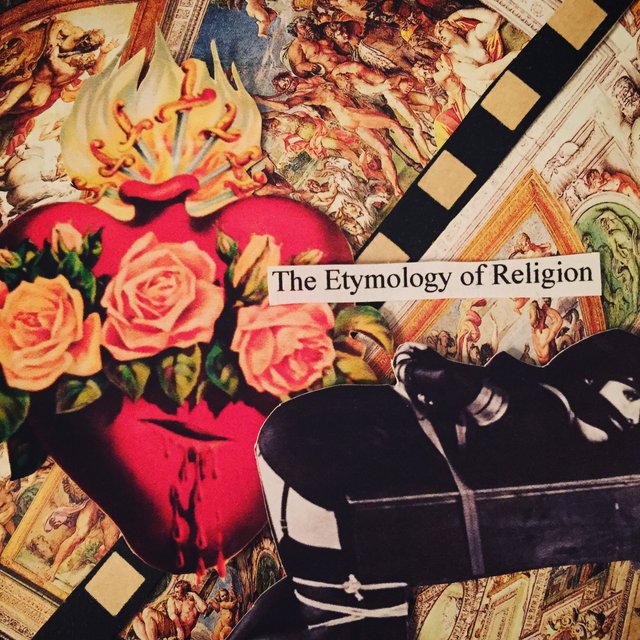The Etymology of Religion //

paper collage by @sexdeathrebirth
Some suppose that the root of the term "religion" comes from the Latin religâre, to bind; or from ligâre, to unite in harmony. The following is the entry for religion from the Online Etymology Dictionary
c. 1200, "state of life bound by monastic vows," also "conduct indicating a belief in a divine power," from Anglo-French religiun (11c.), Old French religion "piety, devotion; religious community," and directly from Latin religionem (nominative religio) "respect for what is sacred, reverence for the gods; conscientiousness, sense of right, moral obligation; fear of the gods; divine service, religious observance; a religion, a faith, a mode of worship, cult; sanctity, holiness," in Late Latin "monastic life" (5c.).
According to Cicero derived from relegere "go through again" (in reading or in thought), from re- "again" (see re-) + legere "read" (see lecture (n.)). However, popular etymology among the later ancients (Servius, Lactantius, Augustine) and the interpretation of many modern writers connects it with religare "to bind fast" (see rely), via notion of "place an obligation on," or "bond between humans and gods." In that case, the re- would be intensive. Another possible origin is religiens "careful," opposite of negligens. In English, meaning "particular system of faith" is recorded from c. 1300; sense of "recognition of and allegiance in manner of life (perceived as justly due) to a higher, unseen power or powers" is from 1530s.
In my view, religion is precisely about uniting with the sacred, becoming one with the sacred, being bound to it. What is the sacred? It is an experience, a transient experience that can barely be grasped. We know it when it happens. The sacred is intimacy, the shared experience of creating new life, the giving and receiving of our artistic and intellectual creations. It cannot be easily defined- it is the subject of Thunder Perfect Mind, the great work of the alchemists, the tantric union, the essence of tao, it is communion. It can be contemplated, sought after, discussed- but paradoxically, we cannot bind the sacred to the boundaries of language. This is why I generally turn to art- to communicate through the language of symbols.
I've including the following passage in a previous post, but its worth revisiting:
"What, for me, is the Sacred? To be more exact: what does my scared consist of? What objects, places, or occasions awake in me that mixture of fear and attachment, that ambiguous attitude caused by the approach of something simultaneously attractive and dangerous, prestigious and outcast- that combination of respect, desire, and terror that we take as the psychological sign of the sacred?"
-Michel Leiris, The Sacred in Everyday Life
The sacred reveals itself to me in the dance of opposites. That's why so much of my art embraces opposites- sex and death, light and dark, male and female... and I'm not afraid to blend erotic and religious imagery. The sacred and the profane meet, eventually.
"I know it when I see it," said US Supreme Court Justice Potter Stewart said in 1964 of hardcore pornography. The sacred works the same way.
I'll end with a reference to the Hermetic Principle of Polarity:
"Everything is dual; everything has poles; everything has its pair of opposites; like and unlike are the same; opposites are identical in nature, but different in degree; extremes meet; all truths are but half-truths; all paradoxes may be reconciled."
@originalworks
@originalworks